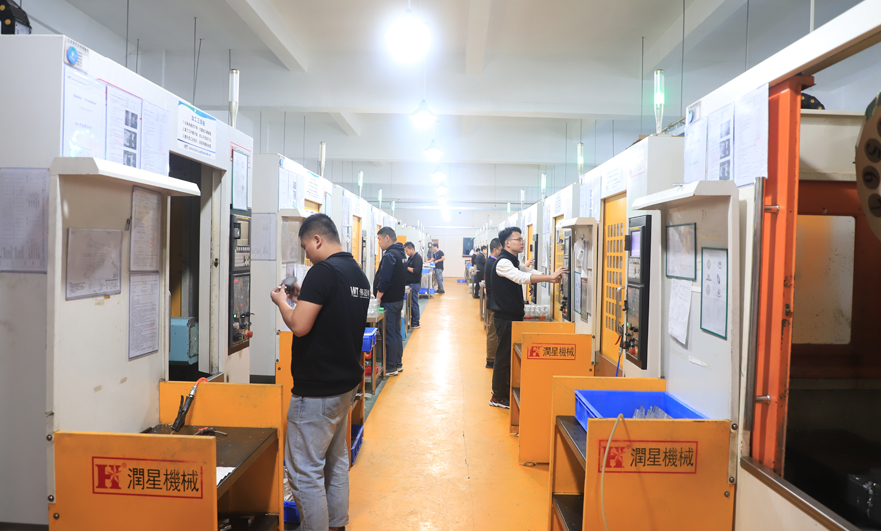15 years one-stop China custom CNC machining parts factory

Hey there I’m VMT Sam!
With 25 years of CNC machining experience we are committed to helping clients overcome 10000 complex part-processing challenges all to contribute to a better life through intelligent manufacturing. Contact us now
 177 |
Published by VMT at Jan 20 2022
177 |
Published by VMT at Jan 20 2022
CNC lathe machining is roughly divided into the following four steps:
1. Carry out numerical calculation, process machining and program design according to the machining technology content required by the CNC parts machining drawings.
2. Write the CNC program according to the program format specified by the CNC machining lathe, and record it completely on the storage medium in the form of code, and then transmit the content of the machining program to the CNC equipment through input (manual, computer transmission, etc.).
3. The CNC machining program (CNC code) received by the CNC system. CNC code is generated by programmers on CAM software or compiled by hand. It is a text data. This expression is relatively intuitive and can be easily understood by programmers. However, it cannot be used directly in hardware.
CNC machining equipment "converts" CNC code to machine code. The CNC machining machine code is a binary file composed of 0 and 1, which is then converted into electrical pulse signals that control the direction of movement such as X, Z, and other auxiliary machining signals to pulse signals. This form is sent to the output port of the CNC machining equipment and the servo system is asked to execute it.
4. According to the pulse signals in the moving directions such as X and Z, the servo system performs numerical control machining and driving on the motion mechanism of the numerical control machine tool (spindle motor, feed motor, etc.). Make the CNC machining lathe automatically complete the corresponding CNC parts machining.
Scope of application CNC parts lathe machining conditions are as follows:
(1) CNC parts with complex shapes and high machining accuracy, especially complex CNC turning curves.
(2) The occasions where the CNC parts are replaced frequently and the production cycle is short.
(3) CNC parts machining for small batch production.
(4) The higher value part.

The division principle of CNC lathe machining technology
1. Divide the clamping and positioning of CNC parts by the process
Due to the different shapes of various CNC parts, the technical requirements of each surface are also different, and the positioning methods in CNC machining are also different. Usually, when CNC machined the shape of the part, it is inside; when CNC machined the shape of the part, it is outside. The process can be divided according to different positioning methods.
2. Rough and fine machining
When dividing the machining process according to the machining accuracy, stiffness and deformation of CNC parts, it can be divided according to the principle of roughing and finishing, that is, the principle of roughing and finishing. At this point, you can use different machines or different tools for CNC machining. Usually, in one installation, it is not allowed to CNC machine some parts of the surface of the part before machining other parts of the CNC part.
In order to reduce the number of tool changes, shorten idle travel time, and reduce unnecessary positioning errors, the same tools can be used to concentrate CNC machining steps and divide the machining steps of CNC parts. Whenever possible, use the same tool to machine all parts that can be CNC machined, then replace the rest of the part with another tool. This method is often used in special CNC machine tools and CNC machining centers.
CNC parts machining division steps
The division of CNC parts machining steps is mainly considered from the two aspects of CNC parts machining accuracy and production efficiency. In the process of machining CNC parts, it is often necessary to use different tools and cutting amounts to machine different surfaces. In order to facilitate the analysis and description of the machining of complex CNC parts, it is subdivided into working steps in the process. The principle of division of labor is:
1. The same machined surface is completed by roughing, semi-finishing and finishing, or the machining surfaces of all CNC parts are separated by roughing and finishing.
2. For CNC parts with both a milling surface and a boring surface, the plane can be milled first, and then the drilling process can be performed. The numerical control machining process is divided according to the method, and the machining accuracy of the hole can be improved. Due to the large cutting force when milling the plane, the CNC machined parts are easily deformed. First CNC milling the plane, and then boring, you can restore the deformation for a period of time and reduce the impact of the deformation on the hole accuracy.
3. According to the use of the tool, the CNC lathe machining is divided into working steps. The CNC turning time of some CNC machine tool tables is shorter than the tool change time. The process can be divided according to the use of the tool, reducing the number of tool replacements and improving the machining efficiency of CNC parts.
Ready To Start Your Next Project?
Get Instant Quote

Request a Free Quote
Send us a message if you have any questions or request a quote. We will get back to you ASAP!